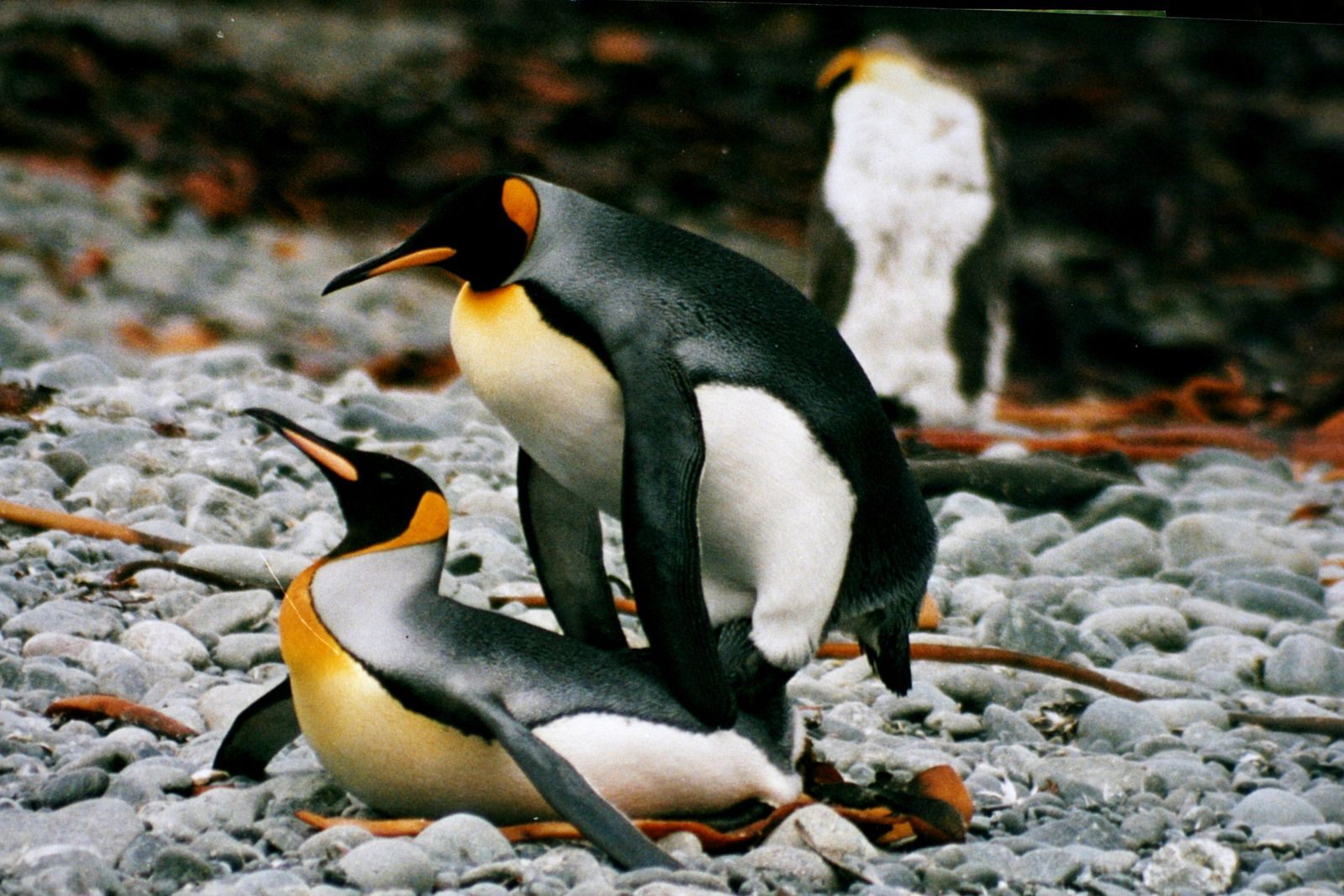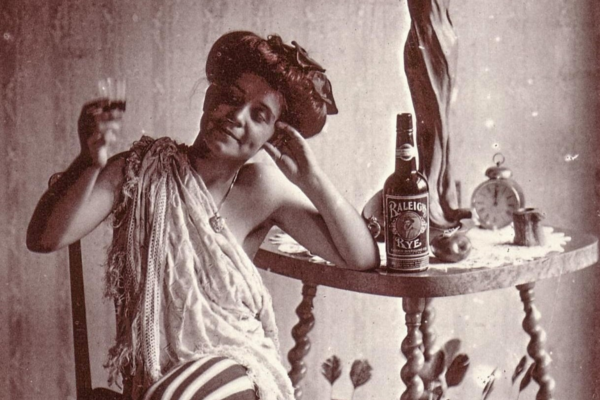Why Are Penguins’ Sex Lives So Scandalous?
Since the early 1900s, these adorable birds have been too freaky for us to handle.

This past fall, a popular TV channel aired a very brief, very controversial documentary. It was debauched and violent, packing a betrayal, a screaming match, and a bloody fight into fewer than three minutes. Outlets including Entertainment Weekly and USA Today covered the clip and the fervent social media response, calling it “shocking” and “disturbing.” “This is why I don’t want to be in a relationship,” one viewer Tweeted.
This contentious clip wasn’t on A&E or Fox News. It was a National Geographic wildlife documentary called “Homewrecking Penguin,” about three Magellanic penguins caught in a love triangle. When the first penguin returns from fishing, he’s confronted by his mate and her new boyfriend, who has moved into his nest. The two males scream and beat each other up—one even loses an eye—and after watching them battle for her affections, the female eventually chooses her new paramour, leaving her original mate out in the cold.
As Twitter user Javi Moreno said, “he should of just skipped the bullsh*t and taken her to Maury.”
This clip’s massive popularity and outsized response—according to Nat Geo News, hundreds of thousands of people watched it the day it was released—rides on the apparent ridiculousness of the pairing: all this blood-soaked drama from penguins? But if you look back at the history of human-penguin relations, this clip isn’t really an anomaly. Over and over, through centuries of shifting scientific standards and evolving social mores, humans have been scandalized by penguins.
A fight breaks out when a husband comes home and finds his wife with another penguin. pic.twitter.com/9ejYGcJ5TJ
— Nat Geo Channel (@NatGeoChannel) November 4, 2016
As far as we know, the first person to be shocked by penguin depravity was a surgeon named George Murray Levick. Part of an early British expedition to Antarctica, Levick spent much of his free time observing the large colonies of Adélie penguins that live on Cape Adare, and he later published several family-friendly descriptions of the species’ lifestyle, habits, and characteristics.
“When seen for the first time, the Adélie penguin gives you the impression of a very smart little man in an evening dress suit,” begins one chapter of the very pleasant Antarctic Penguins, published in 1914. “His carriage is confident as he approaches you over the snow, curiosity in his every movement.”
But eventually, Levick’s experience took a darker turn. The Cape Adare penguins, being animals, treat sex differently than most humans do, and Levick was sufficiently outraged by some of their predilections that he sometimes abandoned the pretense of scientific objectivity. “Cocks were often seen whose passions seemed to have passed beyond their control,” he wrote in an early journal entry.

He began referring to these unattached males as “hooligans,” and described their activities—mating with injured females, with dead penguins, with each other, and occasionally with the snow itself—with breathless fury. “I saw another act of astonishing depravity today,” he wrote on December 6th, 1911, after witnessing a group sex act. “There seems to be no crime too low for these penguins.”
Levick was disturbed enough by what he saw that he did his darndest to make sure his accounts of it would never fall into innocent hands. When he remembered, he switched into the Greek alphabet to write about penguin sex, in order to assure that people without a university education—in other words, the innocent—couldn’t read the offending sections. When he forgot, he went back and rewrote his original observations, pasting the coded Greek version over the original in his notebook.
Levick did try to publish the fruits of these notes as part of a longer paper, but his editors cut all the graphic parts out. (They did keep some copies for their own use, though.) It took until 2012 for ornithologists at London’s Natural History Museum to finally dig up Levick’s “Sexual Habits of the Adelie Penguin”—by which point scientific inquiry had matured enough that they were able to publish it.

In the meantime, humans were busy making a huge deal out of entirely different penguins. In the mid-2000s, the scandal spotlight landed on Roy and Silo, two male chinstrap penguins at the Central Park Zoo. When the two first started hanging out in 1998, they were merely one of the world’s many same-sex penguin couples. They eschewed female companionship, and spent their days entwining their necks and singing to each other.
After zookeepers observed them pretending a round rock was an egg, they gave them a real one, and the two raised up a baby female named Tango. When they eventually broke it off, in 2004, it shouldn’t really have made ripples outside their immediate circles.
But thanks to their location (New York City, a gossip hotbed) and their timing (right in the thick of contemporary gay rights activism) it caused an nationwide incident instead. The breakup “rocked the gay scene,” wrote Andrew Sullivan in the Times of London. Conservative groups—who had, just months before, extolled March of the Penguins for its celebration of traditional family values—jumped in to slander the ex-couple, going so far as to use Silo’s new partner—a female—to delegitimize his old relationship. According to the American Library Association, And Tango Makes Three, a picture book about Roy, Silo, and their baby, was the fourth most controversial book of the 2000s.
Remember the gay penguins, they are very important. pic.twitter.com/8yug00ID8T
— nic (@JustAFanMore) March 10, 2017
To this day, same-sex penguin couples—both their existence and their occasional separation, for breeding purposes—continue to rile up people across the globe. Although many scientists are scandalized by the scandals, others understand where our hysteria comes from. “We tend to identify with penguins because they walk upright and are social,” writes Dr. P. Dee Boersma, a penguin expert at the University of Washington, in an email. She also points out that many do act like humans in other ways too—many do pair off and stay faithful, sometimes for many years.
In the end, it’s probably these similarities that make us so prone to judging these penguins. If these animals—which look like us, but cuter—are capable of cheating, or of attempting to raise stone eggs, or to mate with the snow, what might be lurking just beneath our socialized veneer? As Twitter user BeautifulChaine put it, after watching that National Geographic video, “I never knew I could relate to one until now.”
Naturecultures is a weekly column that explores the changing relationships between humanity and wilder things. Have something you want covered (or uncovered)? Send tips to cara@atlasobscura.com.
















Follow us on Twitter to get the latest on the world's hidden wonders.
Like us on Facebook to get the latest on the world's hidden wonders.
Follow us on Twitter Like us on Facebook